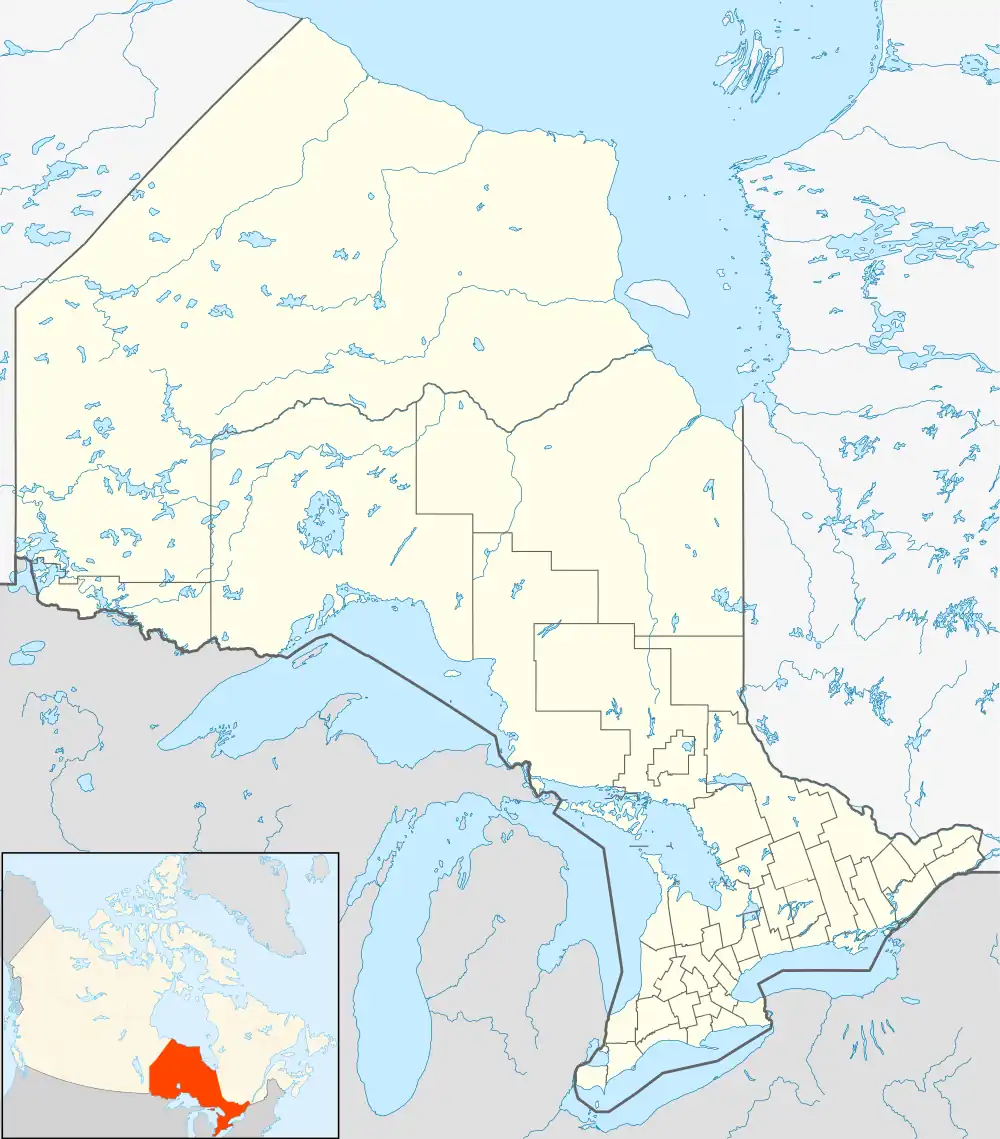O'Connor | |
|---|---|
| Township of O'Connor | |
 | |
| Motto: Country Living at its Best | |
 O'Connor | |
| Coordinates: 48°22′N 89°42′W / 48.367°N 89.700°W | |
| Country | Canada |
| Province | Ontario |
| District | Thunder Bay |
| CMA | Thunder Bay |
| Settled | 1887 |
| Incorporated | 1907 |
| Government | |
| • Mayor | Jim Vezina |
| • Federal riding | Thunder Bay—Rainy River |
| • Prov. riding | Thunder Bay—Atikokan |
| Area | |
| • Land | 108.78 km2 (42.00 sq mi) |
| Population (2016)[1] | |
| • Total | 663 |
| • Density | 6.1/km2 (16/sq mi) |
| Time zone | UTC-5 (EST) |
| • Summer (DST) | UTC-4 (EDT) |
| Postal code | P0T 1W0 |
| Area code | 807 |
| Website | www.oconnortownship.ca |
O'Connor is a township in the Canadian province of Ontario, located 32 kilometres (20 mi) west of the city of Thunder Bay. The municipality was formed on January 1, 1907. The township serves as a bedroom community of Thunder Bay, with some agriculture, and is part of Thunder Bay's Census Metropolitan Area.
The township was opened to settlement in 1887 because of the silver mining boom, and named by the Ontario government after Port Arthur businessman, alderman and police magistrate James Joseph O'Connor (1857–1930).[2]
The current mayor of O'Connor is Jim Vezina. The township has four councillors, Chantal Alkins, Kevin Foekens, Jerry Loan, and Bishop Racicot.[3]
The township maintains a disposal site, a skating rink, basketball court, and a fire station staffed by volunteer fire fighters. The township produces and distributes a newsletter called The Cornerstone.
O'Connor's primary industry is agriculture. Many residents commute to work either to Thunder Bay or the surrounding woodlands.
Geography
The geography of O'Connor is mainly flat open farmland and rolling hills, with the Whitefish River Valley dominating the southeast corner of the township. The township contains many creeks and rivers. The most notable geographic feature is Kakabeka Falls, located in the northeastern corner of the municipality near the community of Kakabeka Falls, Ontario.
Transportation
The municipality is served by highways 590 and 595, which intersect in the northern half of the municipality. Highway 590 connects the community to the Trans-Canada Highway (Highway 11/17) at Kakabeka Falls in neighbouring Oliver Paipoonge.
Demographics
| Year | Pop. | ±% |
|---|---|---|
| 1996 | 739 | — |
| 2001 | 724 | −2.0% |
| 2006 | 720 | −0.6% |
| 2011 | 685 | −4.9% |
| 2016 | 663 | −3.2% |
| [4][1] | ||
In the 2021 Census of Population conducted by Statistics Canada, O'Connor had a population of 689 living in 274 of its 283 total private dwellings, a change of 3.9% from its 2016 population of 663. With a land area of 108.56 km2 (41.92 sq mi), it had a population density of 6.3/km2 (16.4/sq mi) in 2021.[5]
| 2021 | 2016 | 2011 | |
|---|---|---|---|
| Population | 689 (+3.9% from 2016) | 663 (-3.2% from 2011) | 685 (-4.9% from 2006) |
| Land area | 108.56 km2 (41.92 sq mi) | 108.78 km2 (42.00 sq mi) | 108.65 km2 (41.95 sq mi) |
| Population density | 6.3/km2 (16/sq mi) | 6.1/km2 (16/sq mi) | 6.3/km2 (16/sq mi) |
| Median age | 46 (M: 46.8, F: 44.8) | 44.7 (M: 45.4, F: 43.9) | 42.4 (M: 43.1, F: 41.4) |
| Private dwellings | 275 (total) | 272 (total) | 274 (total) |
| Median household income | $89,856 |

Media
The township receives good quality radio from Thunder Bay. Some radio stations from Thunder Bay do not reach this township, such as CILU-FM, The Lakehead University campus radio, and Magic 99.9 FM. Major radio 105.3 The Giant and Rock 94 reach the township with good reception.
See also
References
- 1 2 3 "Census Profile, 2016 Census: O'Connor, Township". Statistics Canada. Retrieved July 12, 2019.
- ↑ F.B. Scollie, Thunder Bay Mayors & Councillors 1873-1945 (Thunder Bay Historical Museum Society, 2000), 121-122
- ↑ O'Connor Township.com directory. Retrieved on 23 September 2007.
- ↑ Statistics Canada: 1996, 2001, 2006, 2011 census
- ↑ "Population and dwelling counts: Canada, provinces and territories, census divisions and census subdivisions (municipalities), Ontario". Statistics Canada. February 9, 2022. Retrieved April 2, 2022.
- ↑ "2021 Community Profiles". 2021 Canadian Census. Statistics Canada. February 4, 2022. Retrieved 2022-04-27.
- ↑ "2016 Community Profiles". 2016 Canadian Census. Statistics Canada. August 12, 2021. Retrieved 2019-07-12.
- ↑ "2011 Community Profiles". 2011 Canadian Census. Statistics Canada. March 21, 2019. Retrieved 2012-03-29.
- ↑ "2006 Community Profiles". 2006 Canadian Census. Statistics Canada. August 20, 2019.
- ↑ "2001 Community Profiles". 2001 Canadian Census. Statistics Canada. July 18, 2021.
